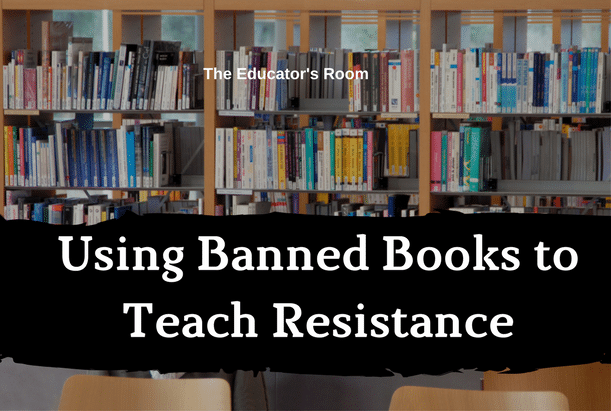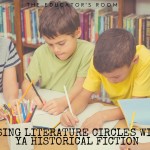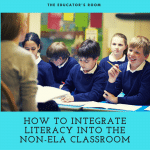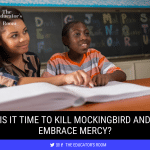Guest Post By Elena Heglund
What might The Lorax by Dr. Seuss, Anne Frank the Diary of a Young Girl
by Anne Frank, A Light in the Attic
by Shel Silverstein, The Giving Tree
by Shel Silverstein, The Giver
by Lois Lowry, and To Kill a Mockingbird
by Harper Lee, all have in common? This is the question I ask my students to ponder as I invite them to explore these books and much more, which are placed in a tantalizing display. They are usually quite puzzled and are even more puzzled when I explain that these books, at one point or another, have been either banned or challenged.
If time is available, I might read them one of the books, in particular, The Giving Tree, and ask them to come up with ideas as to why the book might be challenged. Like so many great teaching ideas, it is not entirely original as it began with a colleague, and it is certainly an idea taught by many with similar strategies, especially during Banned Books Awareness Week in September. The way I teach it is in connection to the novel To Kill a Mockingbird by Harper Lee.
I generally teach it right before Part II of the novel begins since the “Banned Books Lesson” is designed for my 8th graders who are accelerated English 9 students in New York. I will explain to my students that Harper Lee’s novel is frequently challenged, and as we finish the book, I will ask them to keep the question as to why that might be so in mind. I now use this lesson to launch into Task Three Practice on the Regents Exam (New York), which is the argument essay. In this task, students take a position on a controversial subject and must defend it with text evidence from multiple sources about either side of the issue provided on the exam. Therefore, after reading several articles together, the argument essay question I challenge them with is to “Write a source-based argument on the topic: Should schools, libraries, and parents be allowed to ban books?”[1]
After I establish intrigue in the topic and its relation to our current novel, I share with students sections of the American Library Association’s website that explain the difference between a challenged book and a banned book. According to ALA.org, a challenge is an attempt to remove or restrict materials based upon the objections of a person or a group, and banning is a removal of the materials. The top reasons why a book is banned or challenged, as listed by the ALA, are the following:
- The material was considered to be “sexually explicit”
- The material contained “offensive language”
- The materials were “unsuited to any age group”
This is where our discussion begins. However, the trick to the Regents argument essay is that they must be able to argue their point of view by using the opposing view. I know from experience that the vast majority of students will take the position that I hope they will, which is that books should not be banned and intellectual freedom is of the utmost importance. It then becomes my job to play devil’s advocate. Students absolutely must use the counterclaim to their own argument to defend their position, which is an incredibly effective persuasive technique, but it is also quite challenging for students who are first being introduced to this concept.
I found this article by Sharon Coatney to present the argument for restrictive book selection in which she explains that “…banning or censoring books is certainly not a new concept in any kind of library [and] all libraries have specific policies that are followed in selecting books for inclusion in the collection.” Coatney explains that “school librarians, like all teachers [are] considered to be “in loco parentis” and thus responsible for the safety of children,” and part of how she keeps children safe is by her own careful selection of books that are to be accessed by young students.
I always have my eyes out for articles about books being banned, and I was looking for something that could sway students toward considering the counterclaim when I hit the controversial jackpot with the article “The Most Dangerous Book in the World?” by Joseph Berger. The expiration of Hitler’s Manifesto Mein Kampf’s copyright expired in December 2015, allowing any publisher to reprint the full work without proper historical context. The question being presented in the article was, should that be allowed? The students in the accelerated class had already learned about World War II and the Holocaust the year before, and we were able to write about and discuss this article critically as students pondered: is it too dangerous to release this book into the world again at will, or is it a part of understanding the trajectory of history and the danger of hateful rhetoric? [2]
[bctt tweet=”What’s the most dangerous book in the world?” username=”EducatorsRoom”]
But back to the book I teach. After we finish To Kill a Mockingbird, there will be a day when I ask them to revisit the question I asked them to keep in mind as we finished our reading which is to ask themselves, why is it that Harper Lee’s novel remains one of the most challenged books? After this class discussion in which we examine all of the reasons students feel the book might have been banned, I will distribute an article that tells the history of the novel being challenged, such as this one, To Kill a Mockingbird Bird Banned and we will examine the article and the reasons for banning the book. The most recent banning of this piece of literature was in Virginia due to the use of racial slurs and how the parent who issued the challenge felt it was difficult to see past the derogatory terms that appear in the novel. It is true that the language needs to be approached with sensitivity and an explanation of its existence in the book to the time period in which it is written.
My students are prepared in advance to tackle the language in To Kill a Mockingbird because I share with them this poignant article written by a teen who explains how demoralizing the n-word is and also how it should not be censored and written out of historical context, which I interpret to mean that there is a place in historical fiction for the language and our class discusses the pain of hateful rhetoric. However, although that might be the case, I do act in loco parentis and issue my own executive act of censorship of the n-word, and we edit it out when we are reading. I also explain that we will use politically correct language when referring to the book. Teaching in a homogenous demographic, I feel it is imperative for me to impress upon the students that while the characters in the novel might use a term such as “colored” or “Negro” we do not do so now, but that was how people spoke during the Depression Era.
In the end, my students will express how the people who are trying to ban Harper Lee’s Pulitzer Prize-winning novel are most likely missing her message, which is that racism is wrong and that we need to take a stand in the face of injustice. If you pay close attention to the characters in the book, Atticus, the moral compass of Maycomb County, is quite clear in telling his daughter Scout not to use inappropriate language, specifically the “n-word.” Atticus is asked to defend a black man against a white woman’s (untrue) accusations of rape, and even though he knows that the racism of Depression Era Maycomb country will preclude an acquittal for his client Tom Robinson, he explains to his daughter, “ ‘Simply because we were licked a hundred years before we started is no reason for us not to try to win,’” showing by example what it means to do the right thing, to stand up for someone he knows is innocent, even though in the end he knows his task might be insurmountable and he puts his family at risk.
Scout, her brother Jem and their friend Dill learn about the ugly side of the town that they live in, and they shed tears for Tom Robinson, the black man convicted of a rape charge without an iota of medical evidence. If you read the text closely, you will catch the conversation between the children and Miss Maudie after the trial, wherein an angry Jem challenges their neighbor and friend, demanding to know who in the neighborhood did anything at all to help Tom? Miss Maudie then explains to the children how Tom Robinson’s friends in the black community stood beside him the whole time, that Jude Taylor appointed Atticus for this case, even though Atticus is not the defense attorney, because he was the best man for this difficult job, and that people like herself, the children and even the sheriff will all be part of the changes that must be made in their society. Much like Atticus, Miss Maudie knew that even in her heart that the case would not be won, she points out the fact that Atticus could keep the jury out for that long to deliberate over a racially charged case inn 1930s Alabama is a small step forward in the direction where society needs to go.
As for what my students decide to argue in their essay, it has so far been unanimous that books should not be banned, although they consider that some books require guidance or perhaps should be read at a certain age. This lesson strikes a chord with them because they will reference it continuously throughout the year, even after we move on. The truth is the pain of the past cannot be erased, and it should not be. The truth is that there is injustice and ugliness in our world today. Taking books off the shelves and out of the hands of our children because they are controversial is dangerous and is often the result of ignorance or misunderstanding of their content, especially when the books are often written to expose the injustices in the world and to make us think about how they need to be changed.
[bctt tweet=”the pain of the past cannot be erased and it should not be” username=”EducatorsRoom”]
[1] Please note that on the New York Regents exam given to eleventh graders, the students do not know what issue they will be writing about, nor have they read any of the articles prior to the exam. We read the articles together because it is the first time that I approach the task with my students who are technically in 8th grade.
[2] In conducting research for this article for The Educator’s Room, I discovered an annotated version Hitler: Mein Kampf: A Critical Edition, which has been released Mein Kampf Copyright Renewed. I know it will make an excellent addition to our class dialogue this year.







